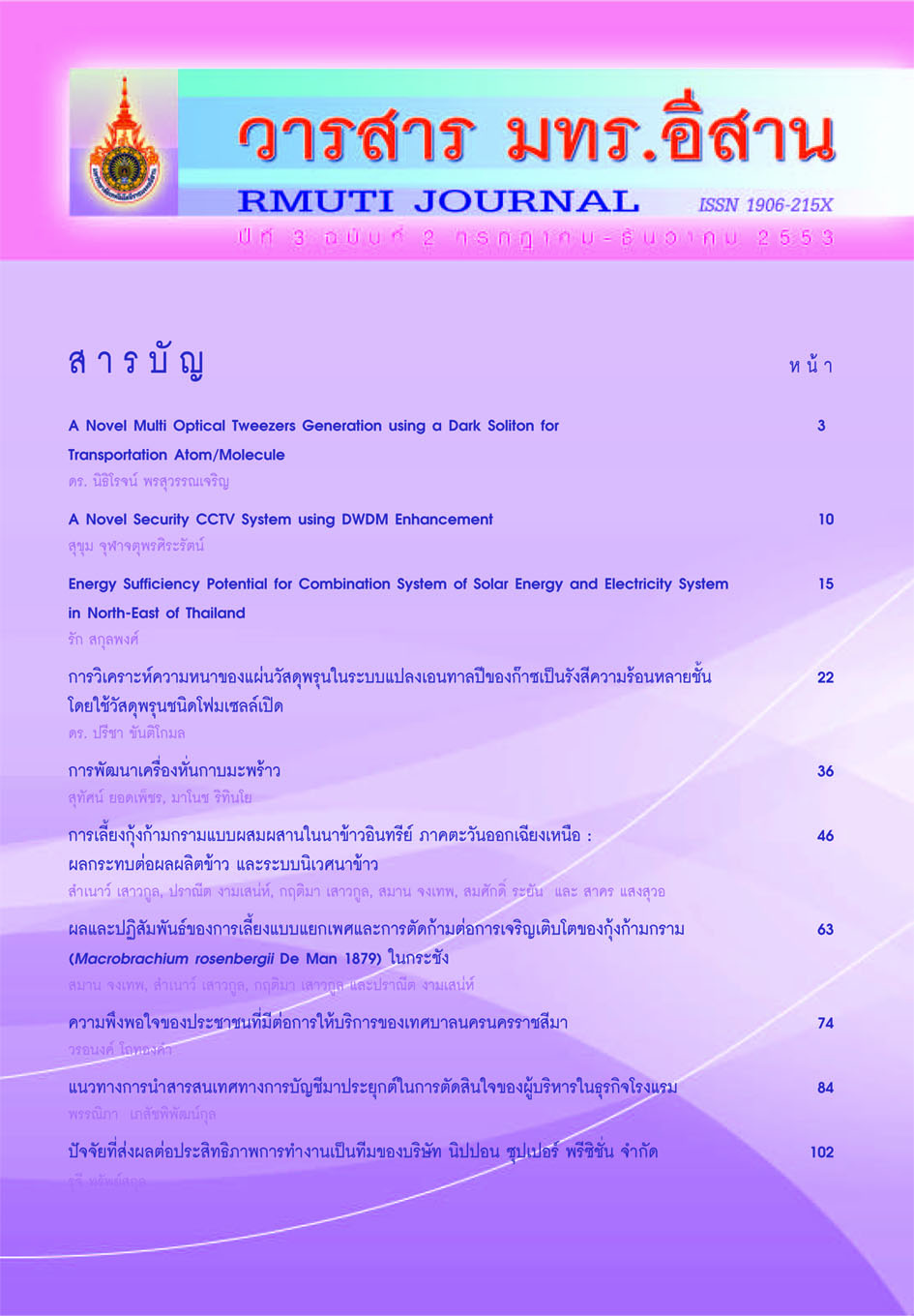การวิเคราะห์ความหนาของแผ่นวัสดุพรุนในระบบแปลงเอนทาลปีของ ก๊าซเป็นรังสืความร้อนหลายชั้นโดยใชวัสดุพรุนชนิดโฟมเซลล์เปีด Ni-Cr An Analysis of Porous Layer’s Thickness on Multilayer Gas Enthalpy- radiation Converter System Utilizing Ni-Cr Open-cellular Porous
Main Article Content
Abstract
บทคัดย่อ
การแปลงเอนทาลปีของก๊าซเป็นรังสีความร้อนโดยใช้วัสดุพรุนชนิดโฟมเซลล์เปีดนิเกิล-โครเมี่ยม (Ni-Cr) หลายชั้น ในการศึกษาครั้งนี้ใช้วัสดุพรุนสองแผ่น ได้ทำการศึกษาทั้งทางภาคทฤษฏี และทางการทดลอง ซี่งผลจากการทดลองใช้เพื่อตรวจสอบความถูกต้องของแบบจำลองทาง คณิตศาสตร์ แบบจำลองทางคณิตศาสตร์ประกอบด้วยสมการพลิ[งงานสองสมการโดยแยก ออกเป็นสองเฟส ได้แก่ สถานะของไหลและสถานะของแข็ง การถ่ายเทพลิงงานมีทั้งสามโหมด ได้แก่ การนำความร้อน (Conduction heat transfer) การพาความร้อน (Convection heat transfer) และการแผ่รังสีความร้อน (Radiation heat transfer) การแลกเปลี่ยนความร้อนระหว่างสถานะ ของไหลและของแข็ง ใช้ความสัมพันธ์ที่ได้จากการวิจัยของ Kamiuto และ San San Yee และ คุณสมบติการแผ่รังสีความร้อนของวัสดุพรุนชนิดโฟมเซลล์เปีดนิเกิล-โครเมี่ยม (Ni-Cr) ใช้ คุณสมบติที่ได้จากการวิจัยของ Kamiuto ในการหาคำตอบของสมการการแผ่รังสีความร้อน (Radiative transfer equation) ใช้วิธีแบบ p approximation และในการหาคำตอบของ สมการพลังงาน'ใช้วิธี'วิเคราะห์เริเงตัวเลข ผลจากการศึกษาพบว่า แบบจำลองมีความแม่นยำ
เมื่อเปรียบเทียบกบผลการทดลอง จึงเป็นการยืนย้นว่าแบบจำลองมีความถูกต้อง ระบบแปลง เอนทาลปีของก๊าซร้อนเป็นรังสีความร้อน (Gas enthalpy-radiation converter) กรณีที่มีความ หนาของแผ่นวัสดุพรุนด้านขาเข้าที่น้อยกว่าด้านขาออกจะกักเก็บความร้อนได้มากกว่า มี ฟสักซ์รังสีความร้อนตามทิศทางการไหล (Forward radiative heat flux) และ ฟสักซ์รังสีความ ร้อนย้อนกลบ (Backward radiative heat flux) จะมีค่าสูงกว่า ความหนาของแผ่นวัสดุพรุน
ชั้นขาเข้ามีอิทธิพลต่ออุณหภูมิตกคล่อมระบบมากกว่าความหนาของแผ่นวัสดุพรุนชั้นขาออก และจะเพิ่มมากขึ้นตามอุณหภูมิของก๊าซขาเข้า จากผลการศึกษาย้งพบอีกว่าความหนาของ แผ่นวัสดุพรุนชั้นขาเข้าย้งมีอิทธิพลต่อความสามารถในการแผ่รังสีความร้อนย้อนกลบไปย้ง บริเวณด้านขาเข้า (Upstream region) มากกว่าแผ่นวัสดุพรุนด้านขาออก
คำสำคัญ :วัสดุพรุน; โฟมเซลล์เปีด; การแผ่รังสีความร้อน; อุณหภูมิตกคล่อม; เอนทาลปีของก๊าซ Abstract
High temperature gas enthalpy-radiation conversion by using multilayer Ni-Cr open-cellular porous plates is numerically and experimentally proposed. Two porous plates are used to construct the multilayer porous gas enthalpy-radiation converter, which are separated by free space. The experimental data based on the same conditions are employed to validate the numerical model. The mathematical model consists of separated energy equations for fluid and solid phases, which include all modes of heat transfer i.e. conduction, convection and radiation heat transfer. The convective heat transfer between the two phases based on an empirical volumetric heat transfer coefficient proposed by Kamiuto and San San Yee is estimated. The Kamiuto radiative property model is used for Ni-Cr open-cellar porous material. The PI approximation method is employed to evaluate the radiation of transfer equation. While explicit finite difference method is used to estimate the energy equations. The validity of the numerical model has been confirmed by the experimental data. The numerical results show that the multilayer gas enthalpy-radiation converter, which consists of thin porous plate as the upstream porous layer and thick porous plate as the downstream porous layer, recover higher energy than that of opposite one. Moreover, the forward and backward radiative heat fluxes within the porous plates are also higher than the case of multilayer porous gas enthalpy-radiation converter that consists of thin porous plate as downstream layer and thick porous plate as the upstream layer. Obviously, thickness of the upstream porous layer is higher effective to increase gas temperature drop across the converter than the thickness of the downstream porous layer. Furthermore, it is also effective to increase the backward radiation into the upstream region, namely it is effective to increase the radiation conversion efficiency.
Keyword: Porous, Open-cellular; Ni-Cr, Radiative heat transfer; Temperature drop; Gas enthalpy-radiation converter


